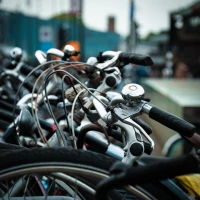Electric bikes, or e-bikes, have surged in popularity as the modern rider demands a blend of environmental consciousness, technological innovation, and of course, speed. The question on every e-bike enthusiast’s mind remains: how fast can an electric bike go? Understanding the capabilities and regulations surrounding your e-bike’s top velocity is crucial not only for efficiency but also for safety and compliance with local laws. In this article, we’ll pedal through the ins and outs of electric bike speeds, gearing up with insights and tips to help you maximize your e-bike’s performance. Whether you’re commuting, tackling trails, or simply cruising, it’s time to shift into high gear and discover the true pace potential of your electric two-wheeler.
The Basics of E-Bike Speed
Before delving into how fast you can zoom on your electric bike, let’s start with the fundamentals. An electric bike typically comes equipped with an electric motor that provides additional power to the pedals, making the ride smoother and less strenuous, especially on inclines or long distances.
Understanding E-Bike Classes
E-bike classification often dictates speed capabilities. Most countries categorize e-bikes into different classes based on their top speed and how the motor assists the rider:
- Class 1: These e-bikes offer pedal-assist up to 20 mph without a throttle.
- Class 2: Similar to Class 1, they also have a 20 mph limit but include a throttle-assisted mode.
- Class 3: These are pedal-assist-only e-bikes with no throttle, reaching top speeds of 28 mph.
The Motor’s Role
The motor is the heart of your e-bike’s propulsion system. Its power, measured in watts, directly correlates with how fast an electric bike can go. E-bikes typically range from 250 to 750 watts, affecting achievable speeds and how efficiently an e-bike can tackle different terrains.
Battery Power and Speed
An e-bike’s battery size and quality not only influence the distance you can travel—referred to as range—but also impact the top speed. A robust, fully charged battery means sustained power output, allowing riders to hit and maintain higher speeds.
Legal Speed Limits for E-Bikes
Safety norms and legal frameworks are essential to balance the benefits of quick commuting with public safety considerations.
Global Speed Regulations
- Around the globe, electric bike speed limits vary.
- The European Union generally restricts e-bikes to a maximum of 25 km/h (15.5 mph).
- In the US, regulations can differ by state but tend to follow the recognized class system, capping speeds at 20 or 28 mph depending on the e-bike class.
Note: Always ensure compliance with local legislation to avoid penalties and ensure safe riding conditions.
Maximizing Your E-Bike’s Top Speed
Are you curious about how to boost your electric bike’s pace? Here’s what you can do:
Proper Maintenance
A well-kept e-bike is a fast e-bike. Regular maintenance such as keeping the chain lubricated, tires inflated to the correct pressure, and batteries adequately charged can prevent energy loss and ensure your e-bike is always performing at its peak.
Upgrade Components
Enhancing certain parts of your e-bike can lead to a significant speed increase. Consider upgrading to a more powerful motor, a larger battery, or smoother tires designed for high-speed travel.
Weight Reduction
The lighter your e-bike, the quicker it can go. Shedding extra weight can be achieved by removing unnecessary accessories or opting for lightweight components.
E-Bike Speed and Riding Techniques
Understanding the mechanical aspects of how to make an electric bike go faster is one thing, but riding technique plays a substantial role too.
Optimize Pedal-Assist Levels
Most e-bikes come with multiple pedal-assist settings. Mastering the optimal level for different riding conditions can maximize your speed and battery efficiency.
Aerodynamic Riding Position
Minimizing wind resistance by adopting a more aerodynamic posture can noticeably increase your speed. This could mean leaning forward and keeping your body tight to the bike’s frame.
Utilize Gears Effectively
If your e-bike has gears, it’s vital to use them correctly. Higher gears can help maintain higher speeds on flatter surfaces, while lower gears are intended for climbing and providing more torque.
Common Misconceptions About E-Bike Speeds
Many riders hold false beliefs regarding the velocity of their electric bikes. Let’s clear up some of these misconceptions:
- More Power Equals More Speed: While a powerful motor aids in reaching high speeds, factors like weight, aerodynamics, and terrain also play crucial roles.
- Speed is Unlimited: Remember that e-bikes are often capped at specific speed limits, meaning there is a maximum velocity that you legitimately cannot exceed.
- Faster E-Bikes Are Always Better: While exhilarating, riding at high speeds increases the risk of accidents and reduces battery life. Balance is key.
E-Bike Speed for Different Uses
The ideal e-bike speed isn’t a one-size-fits-all number. Your top velocity will vary based on how you intend to use your e-bike.
Commuting
For most commuters, safety and consistency are more important than outright speed. Adhering to the standard Class 1 or 2 speeds suffices for a smooth and efficient commute.
Off-Road and Trail Riding
Off-road adventurers may not need the highest speeds due to the nature of the terrain. Instead, power and torque to navigate uneven landscapes take precedence.
Racing and Performance
Those inclined towards speed may seek performance-oriented e-bikes that push the limits within legal boundaries. Bear in mind that racing e-bikes often come with their own set of rules and regulations.
Choosing the Right E-Bike for Your Need for Speed
Selecting an e-bike that meets your speed demands involves careful consideration. Here’s what to look for:
Analyze Your Requirements
Reflect on why you need an e-bike and how you’ll use it. This will guide you towards the appropriate class of e-bike and what specs to prioritize.
Test Ride Different Models
Never underestimate the value of a test ride. Experience firsthand the differences in acceleration, top speed, and overall feel of various e-bikes.
Reviews and Brand Reputation
Research and reviews can point you to e-bikes known for superior speed capabilities and performance. Reputable brands often equate to trustworthy speed claims.
The Future of E-Bike Speeds
With advancing technology, the potential top speed of electric bikes is a domain of considerable excitement. Innovations in motor efficiency, battery power, and lightweight materials promise to continually redefine the ceiling of e-bike velocities.
Innovations to Watch
Keep an eye on emerging battery technologies like solid-state cells, which could offer higher energy densities for longer, faster rides. Also, the integration of smart connectivity in e-bikes may optimize speed regulation based on traffic and terrain data.
Sustainable Speed
As we look forward to faster e-bikes, we must also consider sustainability. The prospect of reducing cars on the road with swift e-bikes is appealing for urban planners and environmentally-conscious riders alike, as long as safety standards keep pace with speed improvements.
Safety and Responsible Riding at High Speeds
While chasing the thrill of high speed on your e-bike, safety should never be compromised. Ensure you are equipped with a quality helmet, high-visibility clothing, and adhere to safe riding practices.
Understand and Respect Traffic Laws
Just like other vehicles, e-bikes are subject to traffic regulations. Familiarize yourself with laws specific to e-bikes, and respect shared roadways and bike lanes.
Skills for High-Speed Handling
Riding fast requires skill and experience. Take the time to develop confidence and control at lower speeds before venturing into faster territory.
Emergency Preparedness
Always be ready for the unexpected. Keep your e-bike’s brakes well-maintained, and carry basic repair tools and a first-aid kit in case of emergencies.
Conclusion: Unleashing Your E-Bike’s Full Potential Responsibly
Understanding how fast an electric bike can go is a multifaceted topic that stretches beyond the simple allure of speed. Whether you’re looking to optimize your commute, take on rough terrain, or enjoy the thrill of racing, it’s clear that the world of e-bikes holds vast potential just waiting to be unlocked. By considering the factors that influence speed, legal limits, and individual usage needs, you can select and tune an e-bike that matches your pace preference while staying safe and legal.
So, ride smart, stay informed, and let your desire for velocity ride in tandem with responsibility. The road ahead is open and swiftly changing as electric bike speeds continue to evolve. Enjoy the journey and the liberating sense of speed, as the e-bike revolution shows no signs of slowing down.










